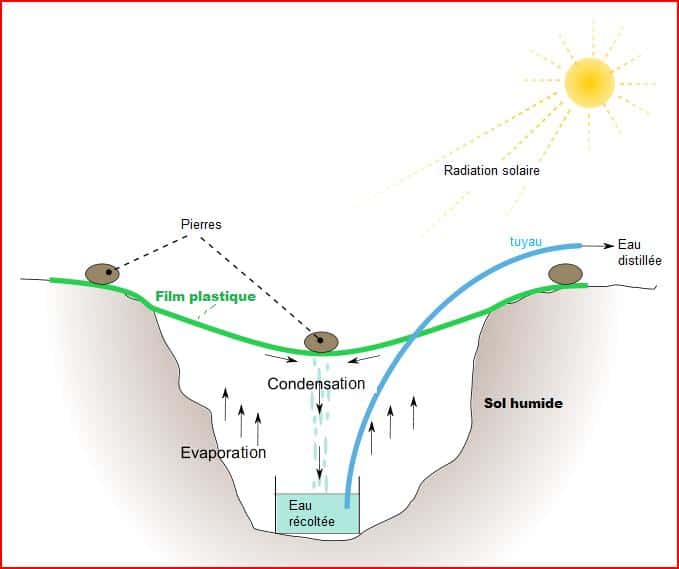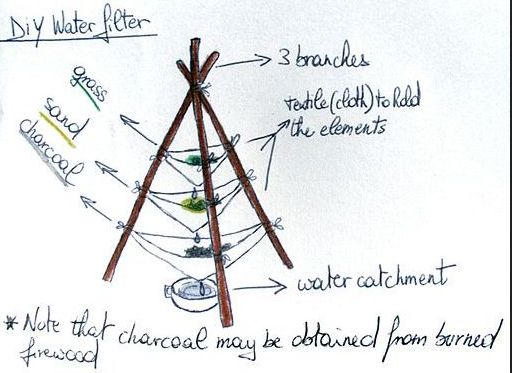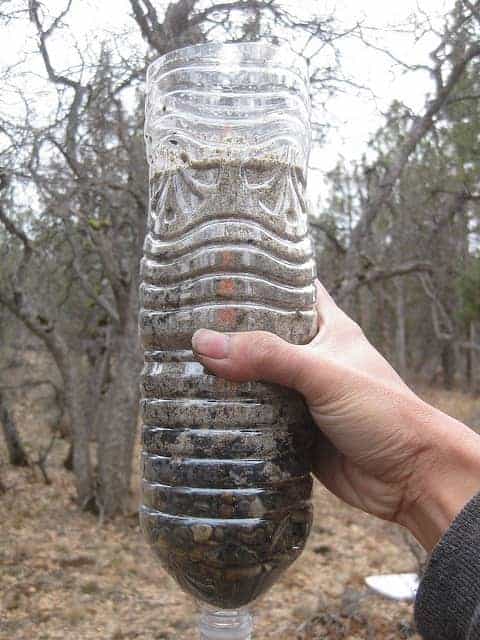5 Ways to Purify and Filter Water without a Filter
Author: Diane Vuković
Last Updated: October 19, 2022
[*]Water is the most essential thing to survival in disaster situations.
Consider that 50-75% of our bodies are comprised of water. We usually don’t feel thirsty until we have lost about 2-3% of our water, but at just 1% dehydration, our performance and mental function will already start to suffer.
For these reasons, I always keep a water filter with me in my survival bag (see how to choose the best survival water filter). But, if I am ever in a survival situation without a filter, I am glad to know these water purification methods.
If you are lost in the wilderness, it may not seem like such a big deal to drink a bit of dirty water (or even water that appears clean). But sadly, most natural water sources are grossly contaminated.
Unpurified water – even from water that appears clean – often contains contaminants like:
The CDC lists some of the possible effects of drinking these contaminants, the main ones being diarrhea and vomiting.
Diarrhea and vomiting can KILL YOU when you are in a survival situation! They will cause you to further dehydrate and can also limit your mobility (not to mention that they aren’t very fun to deal with).
When the water is from sources near urban or agricultural environments, pesticides, herbicides, feces, and chemical runoff are also risks.
The bottom line? Don’t drink unpurified water if you can avoid it!
So what do you do if you don’t have a water filter, UV treatment system, or other water purification method? Use one of these methods!
The problem is that this will require you to have some sort of fire-proof vessel. If you don’t, then you can try rock boiling.
You will need a plastic tarp, but a clear rain poncho would also work.
Here is how you make a solar still:
The idea behind the solar still is that, as the sun shines through the tarp, it will cause moisture to evaporate from the hole and the things in it.
The water vapor will go upwards, hit the tarp, and cool down.
This will create a greenhouse effect and cause condensation to form on the bottom of the tarp. The drops of condensation will drip down into the collection vessel.
Since the drops are from water vapor, the water should be (mostly) clean.
[*]

[*]Image credit: “Puits Solaire” by Solar_still.svg. Licensed under CC BY-SA 3.0 via Commons
You must use charcoal as this is what will absorb harmful bacteria, protozoa, and viruses. The other materials are more for filtering out big pieces of dirt.
Learn how to make DIY activated charcoal
If you have spare cloth, you can build the water filter this way.
[*]

[*]If you don’t have spare cloth, you can make a water filter in a found plastic bottle (luckily, there is usually trash around). If you can’t find a plastic bottle, then you can make a cone out of birch bark for the filter.
[*]

[*]Image credit: Water filter by Ryo Chijiiwa, Work found on Flickr, CC BY NC ND 2.0
Get printable instructions on how to treat water with bleach. I recommend keeping the instructions on your fridge in case you need them!
About 2 feet from a water source like a pond, start digging. You will have to dig DEEP until you hit water and keep digging. The deeper you go, the cleaner the water will be. I honestly can’t imagine ever using this method to purify water, but it is still helpful to know if you ever bug out in the same location for a long time.
Have you ever used any of these methods for purifying water? Let us know your experiences in the comments below.
THANKS TO: https://www.primalsurvivor.net/ways-to-purify-water-survival/
Author: Diane Vuković
Last Updated: October 19, 2022
[*]Water is the most essential thing to survival in disaster situations.
Consider that 50-75% of our bodies are comprised of water. We usually don’t feel thirsty until we have lost about 2-3% of our water, but at just 1% dehydration, our performance and mental function will already start to suffer.
For these reasons, I always keep a water filter with me in my survival bag (see how to choose the best survival water filter). But, if I am ever in a survival situation without a filter, I am glad to know these water purification methods.
Why Do You Need to Purify Water?
Always purify water from an outdoor or unsure source before you drink it!If you are lost in the wilderness, it may not seem like such a big deal to drink a bit of dirty water (or even water that appears clean). But sadly, most natural water sources are grossly contaminated.
Unpurified water – even from water that appears clean – often contains contaminants like:
- Giardia intestinalis
- Cryptosporidium
- Campylobacter
- Salmonella
- E. coli
- Shigella
- Enterovirus
- Hepatitis A
The CDC lists some of the possible effects of drinking these contaminants, the main ones being diarrhea and vomiting.
Diarrhea and vomiting can KILL YOU when you are in a survival situation! They will cause you to further dehydrate and can also limit your mobility (not to mention that they aren’t very fun to deal with).
When the water is from sources near urban or agricultural environments, pesticides, herbicides, feces, and chemical runoff are also risks.
The bottom line? Don’t drink unpurified water if you can avoid it!
So what do you do if you don’t have a water filter, UV treatment system, or other water purification method? Use one of these methods!
Boiling Water
This is the best way to purify water if you don’t have a camping water filter. Boil the water for a minimum of 5 minutes, though it is even safer to boil it for about 20 minutes.The problem is that this will require you to have some sort of fire-proof vessel. If you don’t, then you can try rock boiling.
- Create a vessel to hold your water (such as out of pine bark)
- Make a fire
- Heat rocks in the fire
- Put hot rocks in the vessel with the water
- The rocks will cause the water to boil
- Continue adding hot rocks to keep the water boiling
Solar Still
I wrote about solar stills in my post about uses for a plastic tarp. A solar still is great because it doubles as a water collection method (great for situations where there aren’t any streams, creeks, etc., such as in the desert) and a purification method.You will need a plastic tarp, but a clear rain poncho would also work.
Here is how you make a solar still:
The idea behind the solar still is that, as the sun shines through the tarp, it will cause moisture to evaporate from the hole and the things in it.
The water vapor will go upwards, hit the tarp, and cool down.
This will create a greenhouse effect and cause condensation to form on the bottom of the tarp. The drops of condensation will drip down into the collection vessel.
Since the drops are from water vapor, the water should be (mostly) clean.
[*]

[*]Image credit: “Puits Solaire” by Solar_still.svg. Licensed under CC BY-SA 3.0 via Commons
Build a Grass-Gravel-Charcoal Water Filter
There are a few different ways to build these DIY water filters. They all work on the same basic principle: the water goes through various layers of grass, gravel/sand, and charcoal. During each step, impurities in the water are removed.You must use charcoal as this is what will absorb harmful bacteria, protozoa, and viruses. The other materials are more for filtering out big pieces of dirt.
Learn how to make DIY activated charcoal
If you have spare cloth, you can build the water filter this way.
[*]

[*]If you don’t have spare cloth, you can make a water filter in a found plastic bottle (luckily, there is usually trash around). If you can’t find a plastic bottle, then you can make a cone out of birch bark for the filter.
[*]

[*]Image credit: Water filter by Ryo Chijiiwa, Work found on Flickr, CC BY NC ND 2.0
Bleach for Purifying Water
In urban emergencies where you are without clean water, bleach will likely be the best way to purify water. The EPA says bleach will kill most disease-causing microorganisms (though it will not remove chemical contaminants). They give these instructions:Get printable instructions on how to treat water with bleach. I recommend keeping the instructions on your fridge in case you need them!
Using the Ground to Filter Water
With this method, you dig a well next to a water source. The idea is that the ground will filter out most contaminants at the water’s surface or in the water source.About 2 feet from a water source like a pond, start digging. You will have to dig DEEP until you hit water and keep digging. The deeper you go, the cleaner the water will be. I honestly can’t imagine ever using this method to purify water, but it is still helpful to know if you ever bug out in the same location for a long time.
Have you ever used any of these methods for purifying water? Let us know your experiences in the comments below.
THANKS TO: https://www.primalsurvivor.net/ways-to-purify-water-survival/






 Sat Mar 23, 2024 11:33 pm by globalturbo
Sat Mar 23, 2024 11:33 pm by globalturbo

